Request Information
Ready to find out what MSU Denver can do for you? We’ve got you covered.
As advancements in artificial intelligence continue to impact our academic and professional lives, it’s essential to harness its capabilities responsibly. This page provides students and faculty with practical tips and strategies across a range of AI applications—from writing and reading assignments to creating visual content and studying effectively.
Each resource offers step-by-step guidance to ensure ethical use, enhance learning experiences, foster a deeper understanding of AI’s potential and limitations, and support creation of effective prompts.
Whether you’re new to generative AI or looking to refine your skills, these best practices are designed to promote accuracy, creativity, and critical thinking, preparing the MSU Denver community to embrace the future of learning with confidence and curiosity.
This AI-generated video provides an overview of the best practices for leveraging generative AI as a resource for augmenting the learning experience and serves as an entry into understanding the basics principles of ethical and responsible genAI use.
This video was created using Synthesia, a genAI text-to-video tool.
These resources have been developed to support faculty and students interested in leveraging generative to augment teaching and learning at MSU Denver. Each image is available for individual download directly from this site (along with recommended alt text) and can be downloaded “in bulk” here.
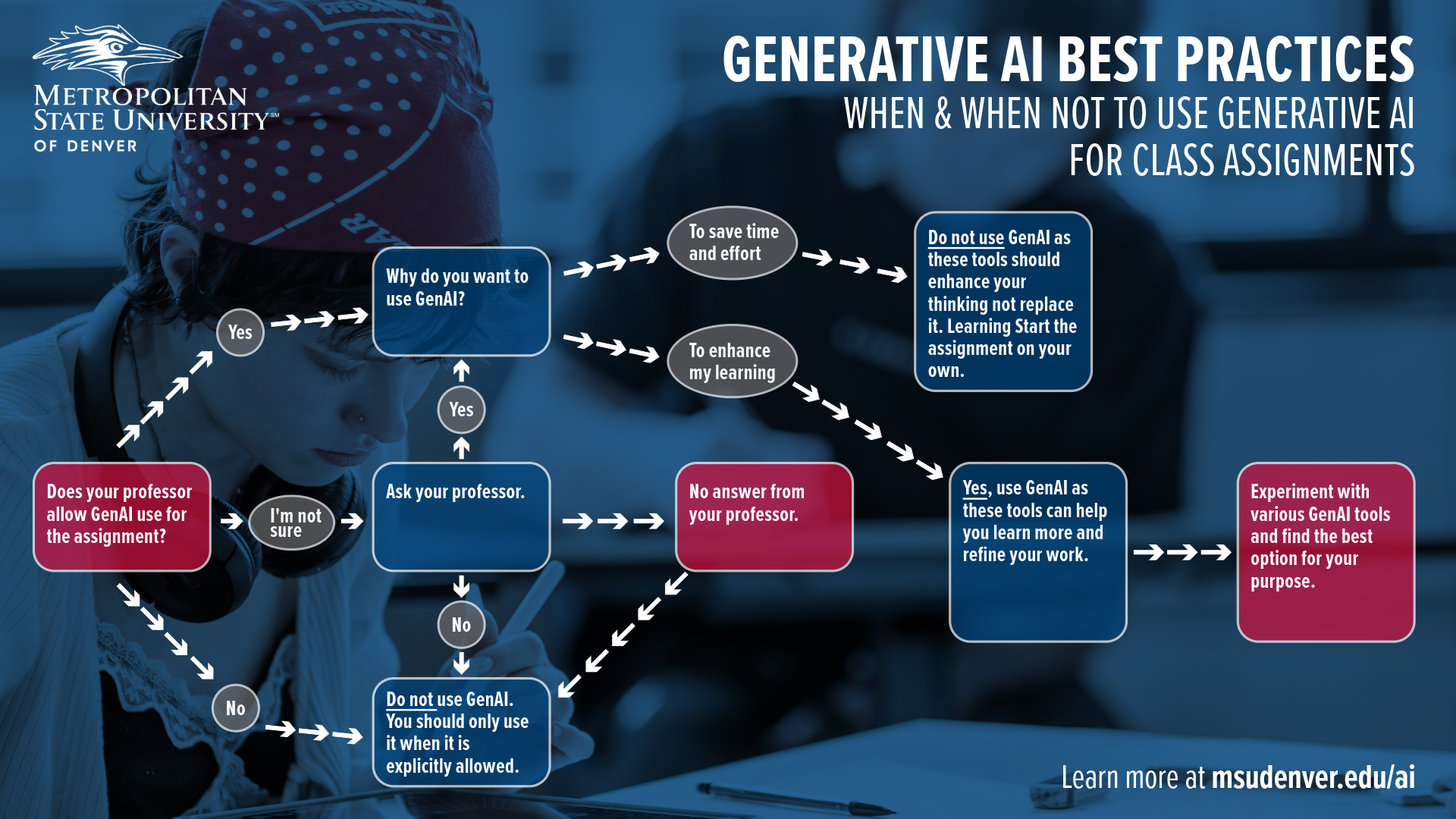
Student decision tree from Metropolitan State University of Denver titled ‘Generative AI Best Practices: When & When Not to Use Generative AI for Class Assignments.’ The flowchart helps students determine whether to use generative AI tools for their assignments:
The image encourages responsible and ethical use of generative AI in academic work, guiding students to make informed decisions. Learn more at msudenver.edu/ai.
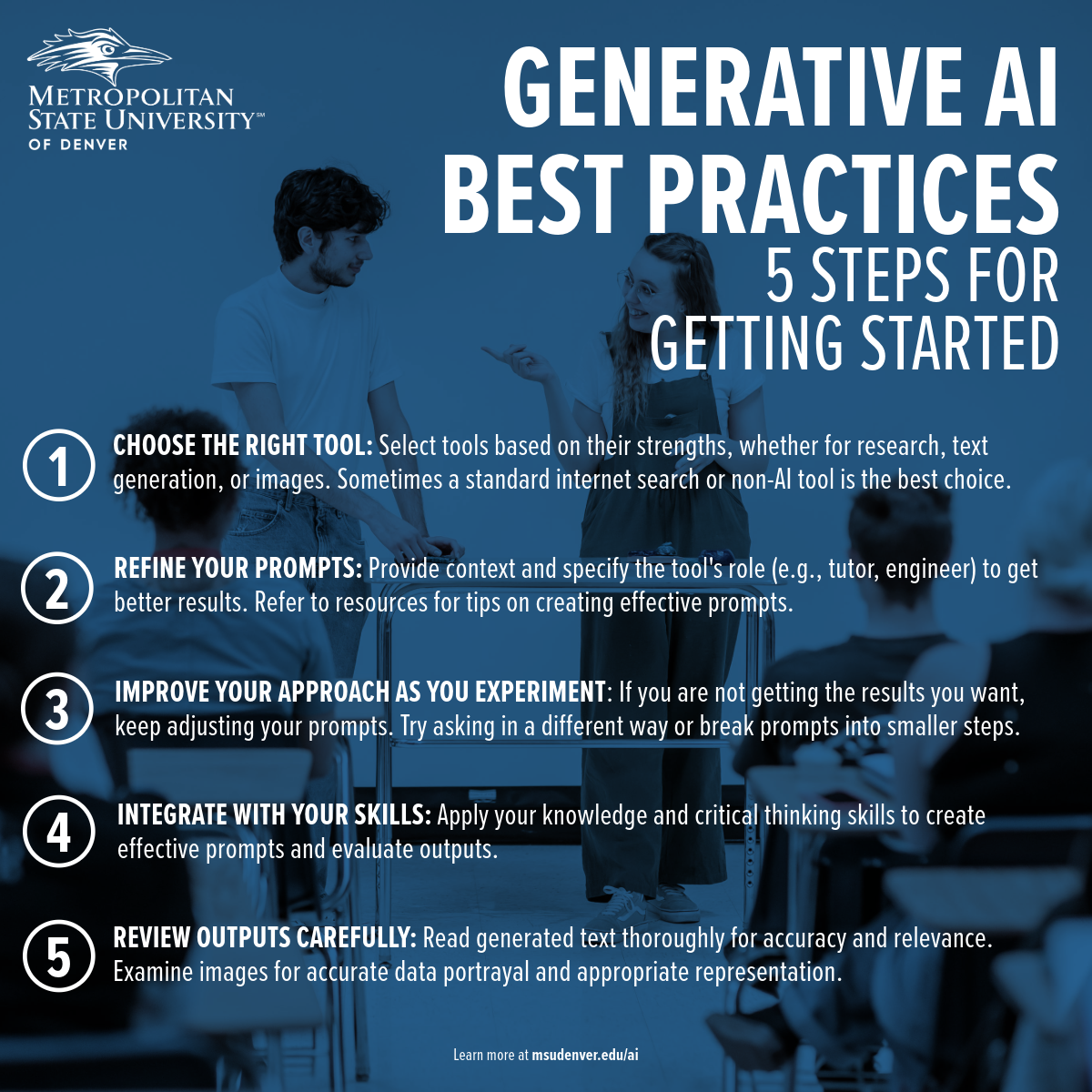
Suggested alt text for sharing resource: “Student support material from Metropolitan State University of Denver on generative AI best practices for getting started. Key steps include: 1. Choose the right tool based on its strengths, such as research, text generation, or image creation, considering even non-AI tools. 2. Refine your prompts by providing context and specifying the tool’s role, like tutor or engineer, and consult resources for effective prompt creation. 3. Improve your approach as you experiment by adjusting your prompts if results are not satisfactory. 4. Integrate with your skills by applying your knowledge and critical thinking to create effective prompts and evaluate outputs. 5. Review outputs carefully to ensure accuracy and relevance in generated text and appropriate data portrayal in images. Learn more at msudenver.edu/ai.”
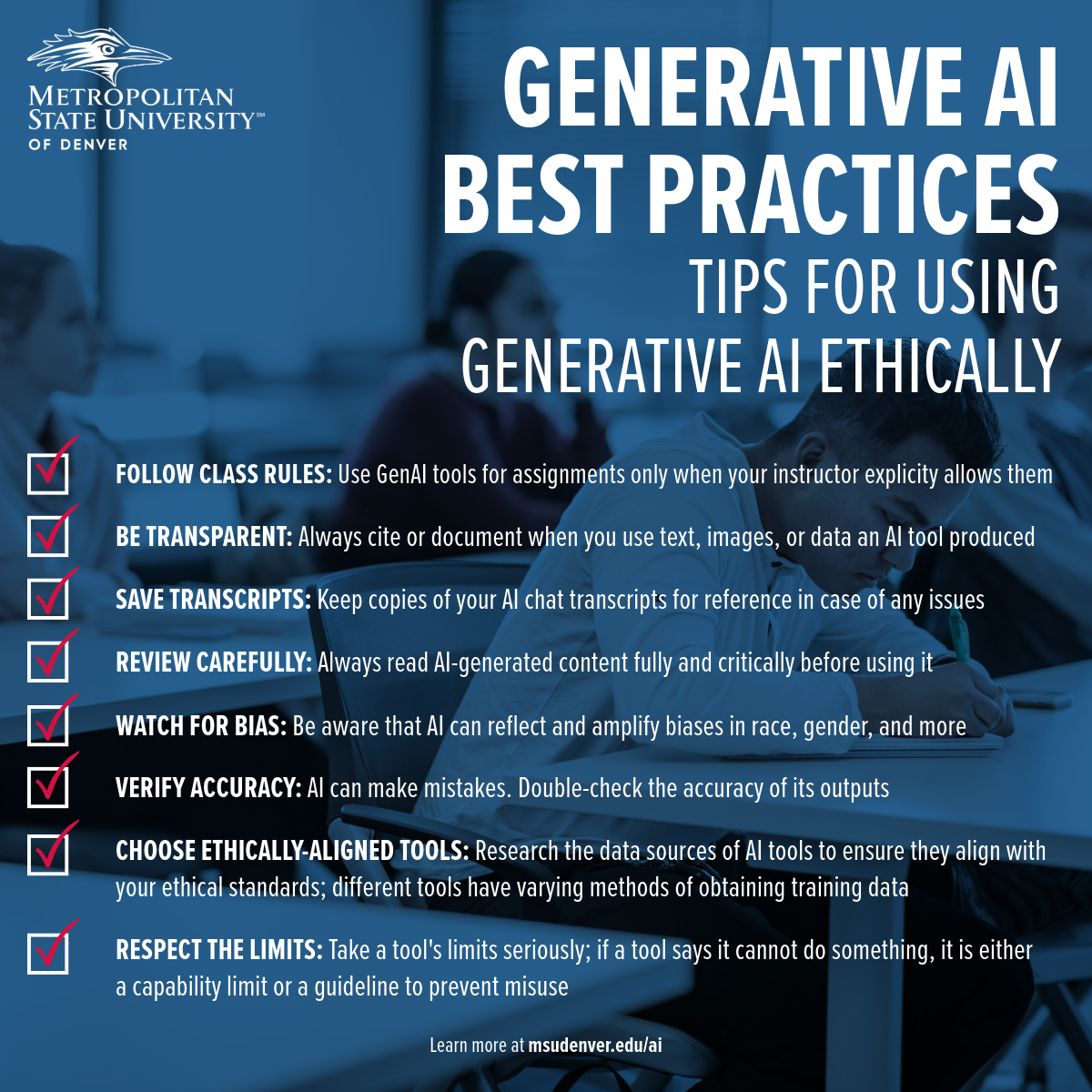
Suggested alt text for sharing resource: “Student support material from Metropolitan State University of Denver on best practices for using generative AI ethically. The tips include: 1. Follow class rules by using GenAI tools for assignments only when permitted by your instructor. 2. Be transparent by always citing or documenting your use of text, images, or data produced by an AI tool. 3. Save transcripts of all your AI interactions for future reference. 4. Review AI-generated content carefully and critically before use. 5. Watch for bias in AI outputs related to race, gender, and more. 6. Verify the accuracy of AI results by double-checking outputs. 7. Choose ethically-aligned tools by researching the data sources and methods they use. 8. Respect the limits set by tools to prevent misuse. Additional information is available at msudenver.edu/ai.”
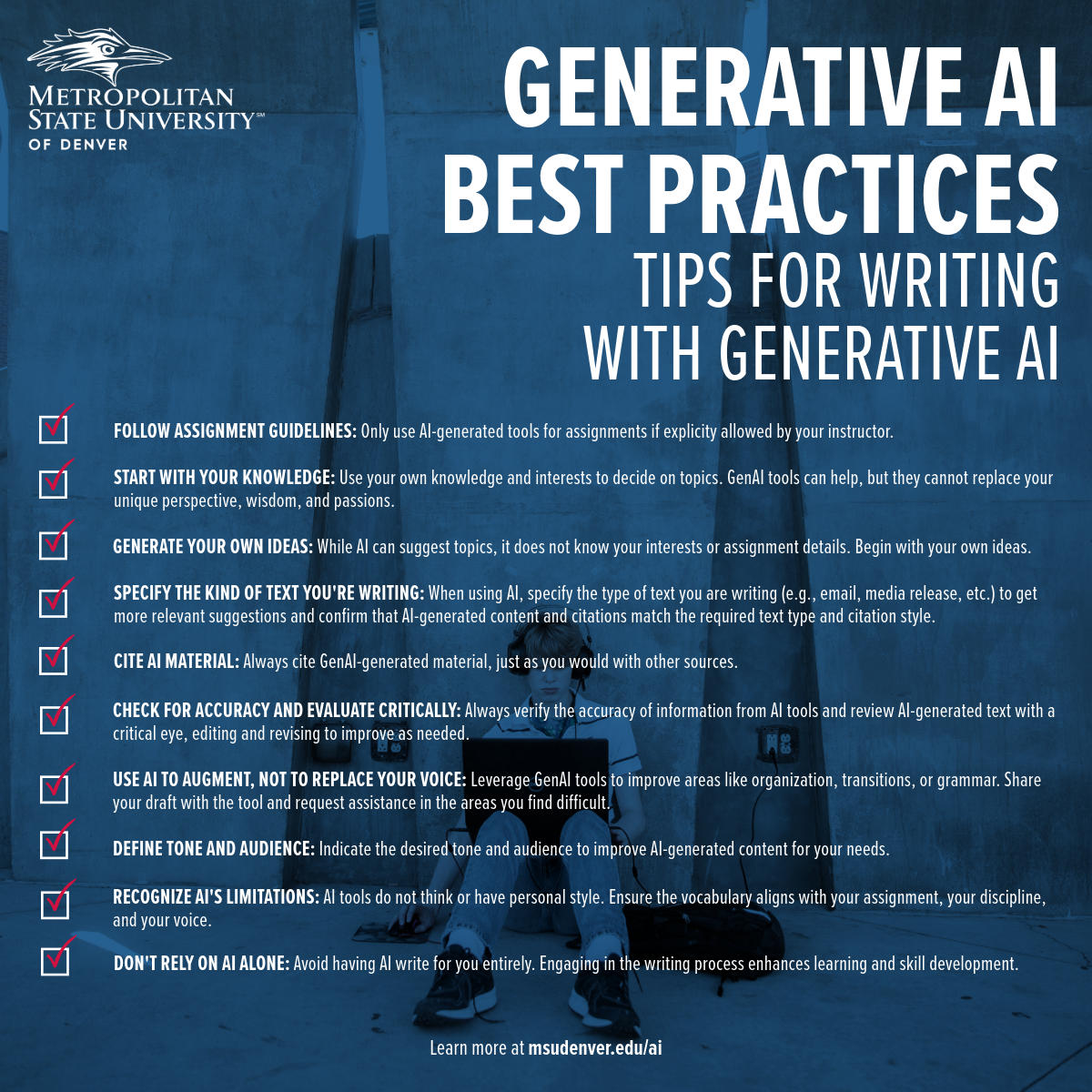
Suggested alt text for sharing resource: “Student support material from Metropolitan State University of Denver outlining best practices for writing with generative AI. The tips include: 1. Follow assignment guidelines and use AI tools only as permitted. 2. Start with your knowledge and interests when choosing topics, as AI tools cannot replace your unique perspective. 3. Generate your own ideas before consulting AI. 4. Specify the type of text you’re writing, like emails or media releases, to ensure appropriate AI suggestions. 5. Cite all AI material just as you would with other sources. 6. Check for accuracy and critically evaluate AI-generated content. 7. Use AI to augment your voice, not replace it, particularly in areas of organization, grammar, or where you need support. 8. Define your intended audience to tailor AI content. 9. Recognize AI’s limitations in style and personal touch. 10. Don’t rely solely on AI for writing, to enhance learning and skill development. More information is available at msudenver.edu/ai.”
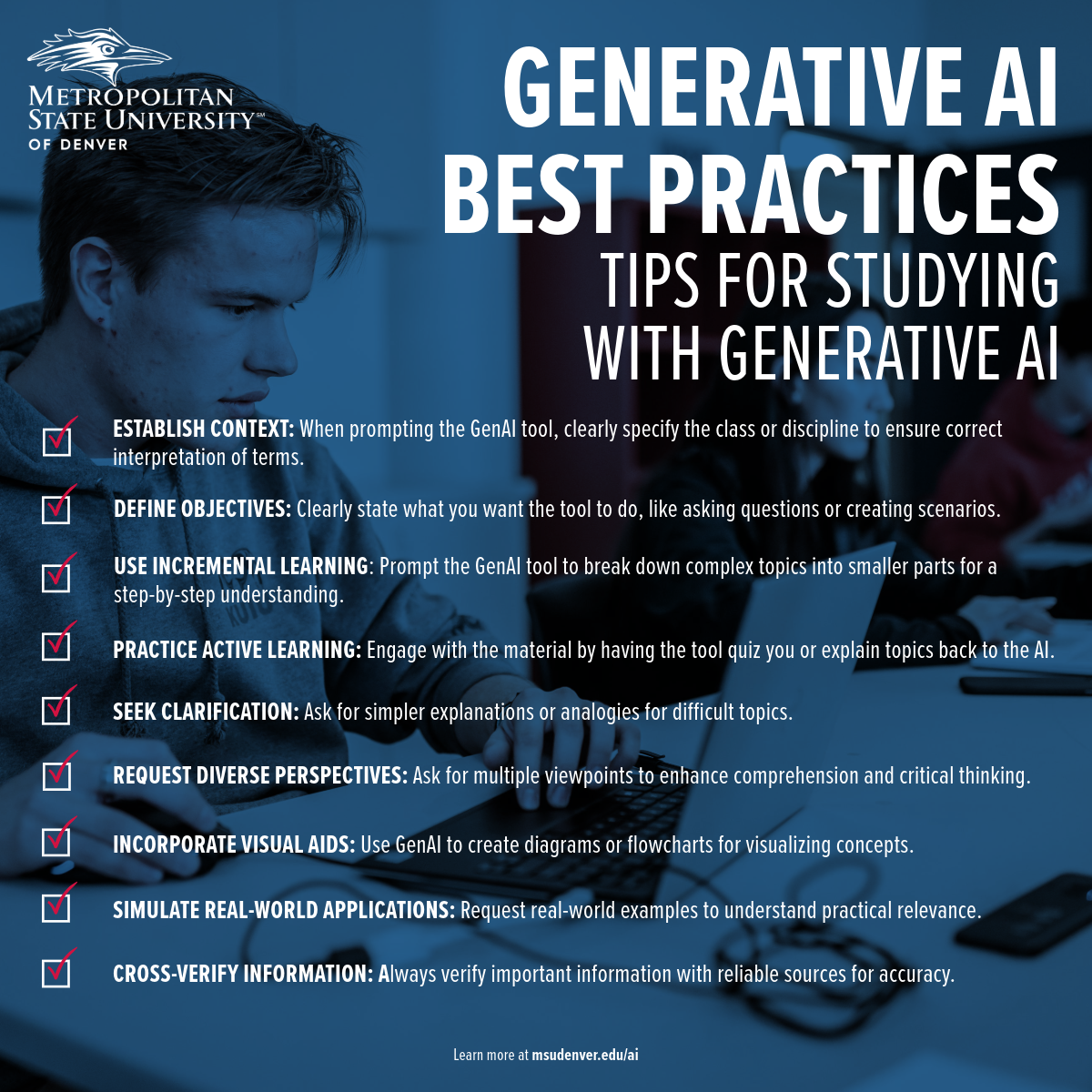
Suggested alt text for sharing resource: “Student support material from Metropolitan State University of Denver providing best practices for studying with generative AI. Key tips include: 1. Establish context by clearly specifying the class or discipline when using GenAI to ensure accurate interpretations. 2. Define your objectives for what you want the AI to do, like posing questions or creating scenarios. 3. Use incremental learning, prompting GenAI to break down complex topics into manageable steps. 4. Practice active learning by engaging with the material through quizzes or explanations. 5. Seek clarification from AI for simpler explanations or analogies on difficult topics. 6. Request diverse perspectives to enhance understanding and critical thinking. 7. Incorporate visual aids like diagrams or flowcharts using GenAI for better concept visualization. 8. Simulate real-world applications by asking for practical examples. 9. Cross-verify information with reliable sources to ensure accuracy. More information is available at msudenver.edu/ai.”

Suggested alt text for sharing resource: “Student support material from Metropolitan State University of Denver outlining generative AI best practices for tasks and tools. It highlights tools for various applications: For text generation, the tools mentioned are Copilot, Gemini, and ChatGPT. For image creation, the tools include Copilot, Gemini, ChatGPT, Firefly (Adobe), DALL-E, Canva, and Midjourney. For research, especially in STEM, the recommended tools are Perplexity, Semantic Scholar, and Elicit. The background features students in a classroom setting, engaging with the content. More information can be found at msudenver.edu/ai.”

Suggested alt text for sharing resource: “Student support material from Metropolitan State University of Denver detailing best practices for maintaining privacy with generative AI tools. Tips include: 1. Adjust privacy settings to keep your inputs private and prevent their use in future training data. 2. Use university-provided tools such as Copilot and Adobe, secured by Microsoft to ensure your data is not used for training. 3. Protect sensitive information by not sharing any identifying, protected, or confidential data in your prompts. 4. Respect others’ privacy by being cautious when uploading documents like course materials. 5. Be aware of metadata that can reveal locations or other unintended information in photos, videos, and visual outputs. The bottom of the image directs students to learn more at msudenver.edu/ai.”

Suggested alt text for sharing resource: “Student support material from Metropolitan State University of Denver providing best practices for reading with generative AI. The tips include: 1. Start by reading the assigned text yourself and jot down any questions before using GenAI tools to find answers. 2. Attach the text for specific queries when using AI tools, providing clear and precise questions. 3. Provide context for questions about your reading to help the AI understand the topic better. 4. Ask for detailed summaries from AI to gauge an article’s relevance. 5. Evaluate research sources by reading abstracts and asking AI for summaries. 6. Compare the AI’s interpretations with your own and seek clarification if needed. 7. Verify all information provided by AI against the actual text. 8. Trust your judgement and not rely solely on AI, as it may not align with your specific learning goals. 9. Engage with the material actively, using AI as a tool to enhance understanding but investing time to learn deeply. More information is available at msudenver.edu/ai.”
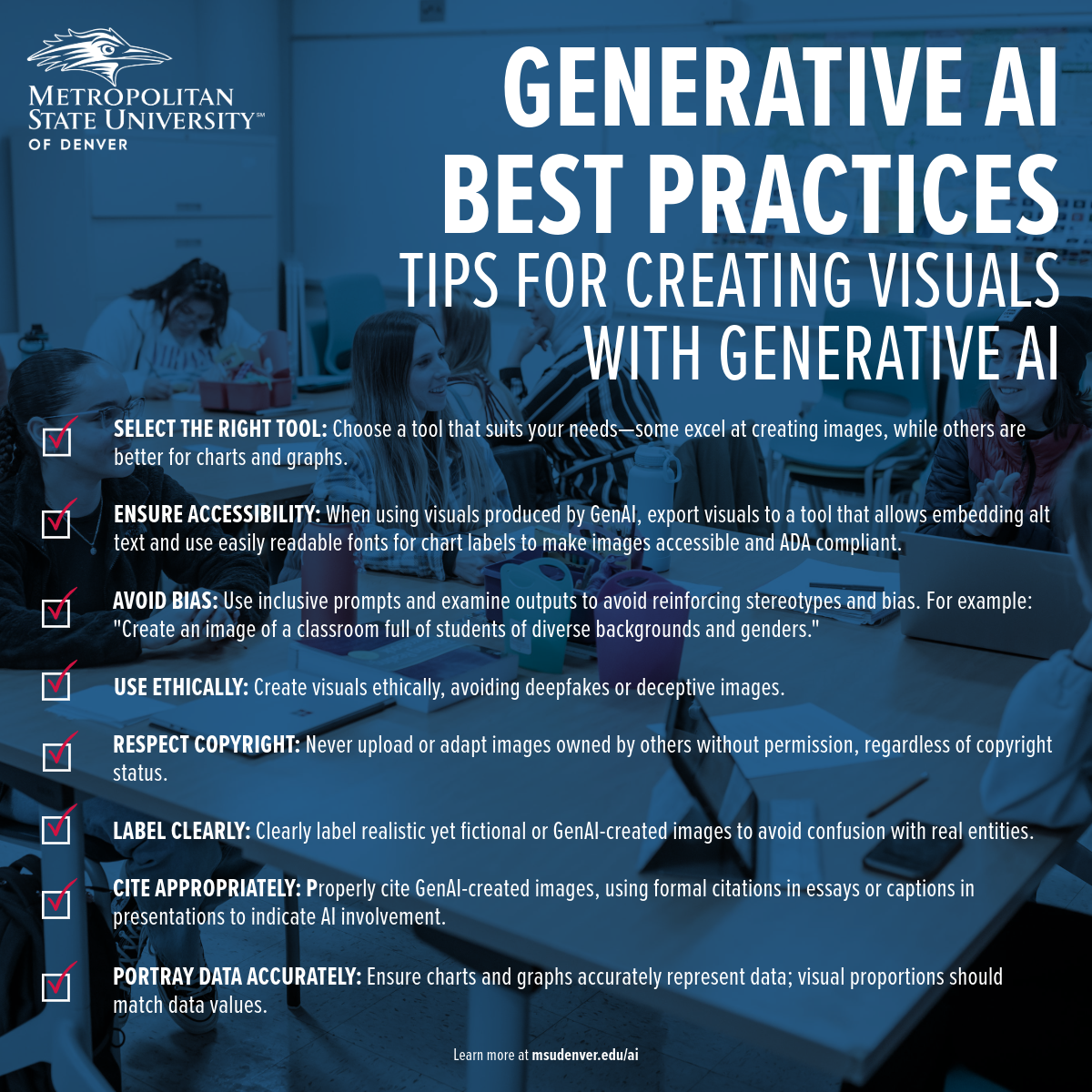
Suggested alt text for sharing resource: “Student support material from Metropolitan State University of Denver providing best practices for creating visuals with generative AI. Key tips include: 1. Select the right tool that matches your needs, with some tools better suited for images and others for charts and graphs. 2. Ensure accessibility by exporting visuals to platforms that allow embedding alt text and using readable fonts for chart labels to comply with ADA standards. 3. Avoid bias by using inclusive prompts and critically reviewing outputs to prevent stereotypes. 4. Use visuals ethically, steering clear of deepfakes or deceptive images. 5. Respect copyright by not using images owned by others without permission. 6. Label images clearly to differentiate between real and AI-generated visuals. 7. Cite AI-created images appropriately in presentations or essays to indicate AI involvement. 8. Portray data accurately in charts and graphs to ensure visual proportions match the data values. More information is available at msudenver.edu/ai.”
To get the most out of generative AI tools, it is important to learn how to use them well. Here are some tips for preparing effective prompts to ensure you are getting real value from these tools, whether you are using them to enhance your teaching or to assist in your learning. 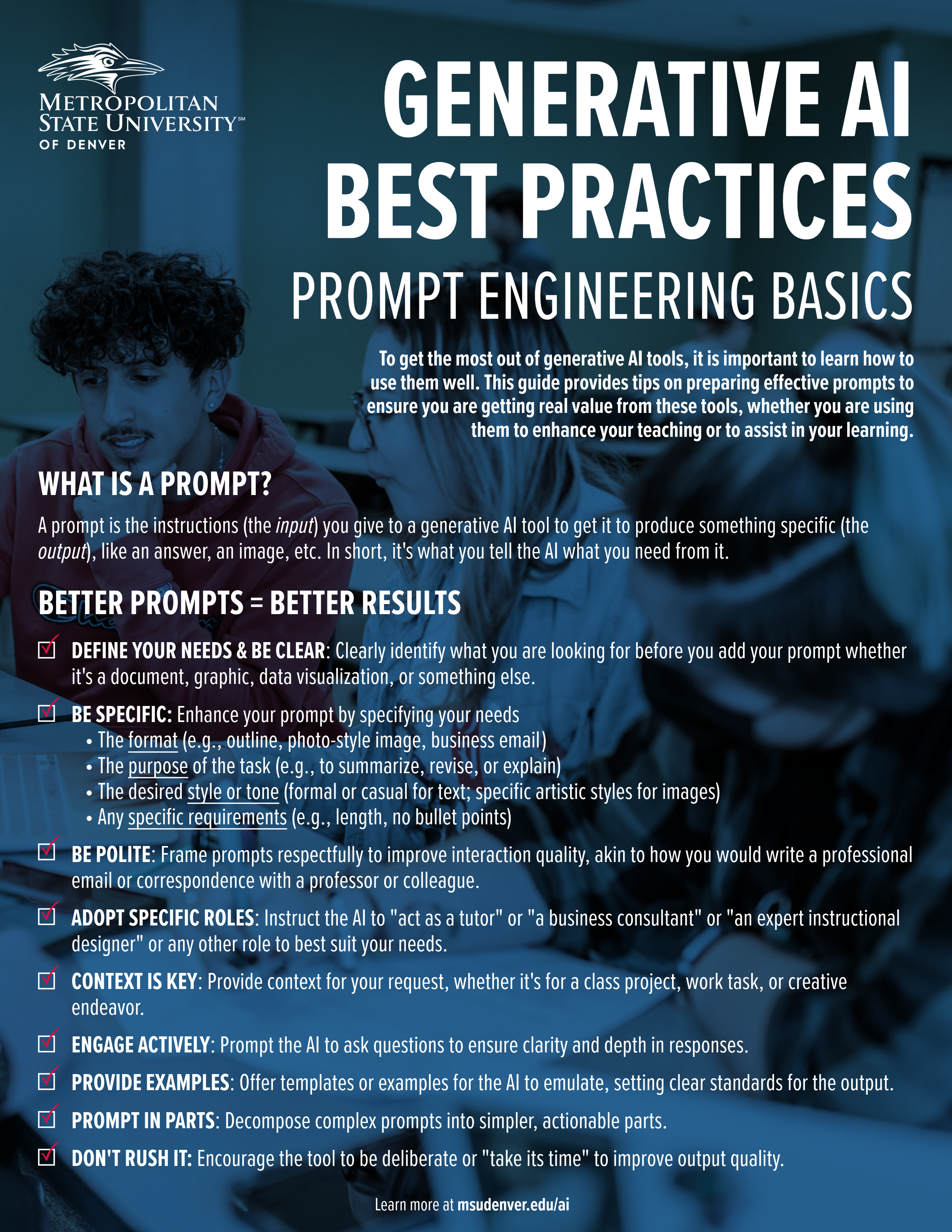
WHAT IS A PROMPT?
A prompt is the instructions (the input) you give to a generative AI tool to get it to produce something specific (the output), like an answer, an image, etc. In short, it’s what you tell the AI what you need from it.
BETTER PROMPTS = BETTER RESULTS